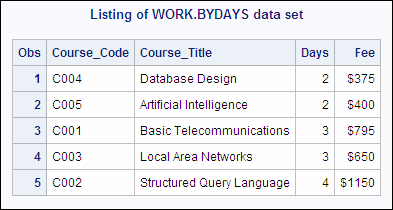Storing Macro Definitions in External Files
Overview
One way to store macro
programs permanently is to save them to an external file. You can
then use the %INCLUDE statement to insert the statements that are
stored in the external file into a program. If the external file contains
a macro definition, the macro is compiled when the %INCLUDE statement
is submitted. Then the macro can be called again later in the same
program, or anytime later in the current SAS session.
|
General form, %INCLUDE
statement:
%INCLUDE file-specification </SOURCE2>;
file-specification
describes the location
of the file that contains the SAS code to be inserted.
SOURCE2
causes the SAS statements
that are inserted into the program to be displayed in the SAS log.
If SOURCE2 is not specified in the %INCLUDE statement, then the setting
of the SAS system option SOURCE2
controls whether the inserted code is displayed.
|
By storing your macro
program externally and using the %INCLUDE statement, you gain several
advantages over using session-compiled macros.
-
The source code for the macro definition does not need to be part of your program.
-
A single copy of a macro definition can be shared by many programs.
-
Macro definitions in external files are easily viewed and edited with any text editor.
-
No special SAS system options are required in order to access a macro definition that is stored in an external file.
Example
You can compile a macro
by using the %INCLUDE statement to insert its definition into a program.
Then you can call the macro in order to execute it.
Suppose the following
macro definition is stored in the external file C:sasfilesprtlast.sas:
%macro prtlast;
%if &syslast ne _NULL_ %then %do;
proc print data=&syslast (obs=5);
title "Listing of &syslast data set";
run;
%end;
%else
%put No data set has been created yet.;
%mend;You could submit the
following code to access, compile, and execute the
Prtlast macro.
The PROC SORT step is included in this example in order to create
a data set that the Prtlast macro can
print. %include 'c:sasfilesprtlast.sas' /source2; proc sort data=sasuser.courses out=bydays; by days; run; %prtlast
Note: The location and names of
external files are specific to your operating environment.
The following messages
are written to the SAS log when this code is submitted. Notice that
the macro definition is written to the log because SOURCE2 was specified
in the %INCLUDE statement.
NOTE: %INCLUDE (level 1) file prtlast.sas is file C:sasfilesprtlast.sas. 31 +%macro prtlast; 32 + %if &syslast ne _NULL_ %then %do; 33 + proc print data=&syslast(obs=5); 34 + title “Listing of &syslast data set”; 35 + run; 36 + %end; 37 + %else 38 + %put No data set has been created yet.; 39 +%mend; NOTE: %INCLUDE (level 1) ending. 40 41 proc sort data=sasuser.courses out=bydays; 42 by days; 43 run; NOTE: There were 6 observations read from the dataset SASUSER.COURSES. NOTE: The data set WORK.BYDAYS has 6 observations and 4 variables. NOTE: PROCEDURE SORT used: real time 0.04 seconds cpu time 0.04 seconds 44 45 %prtlast NOTE: There were 5 observations read from the dataset WORK.BYDAYS. NOTE: PROCEDURE PRINT used: real time 1.07 seconds cpu time 0.26 seconds |
Here is the output that
the code generates.
..................Content has been hidden....................
You can't read the all page of ebook, please click here login for view all page.

